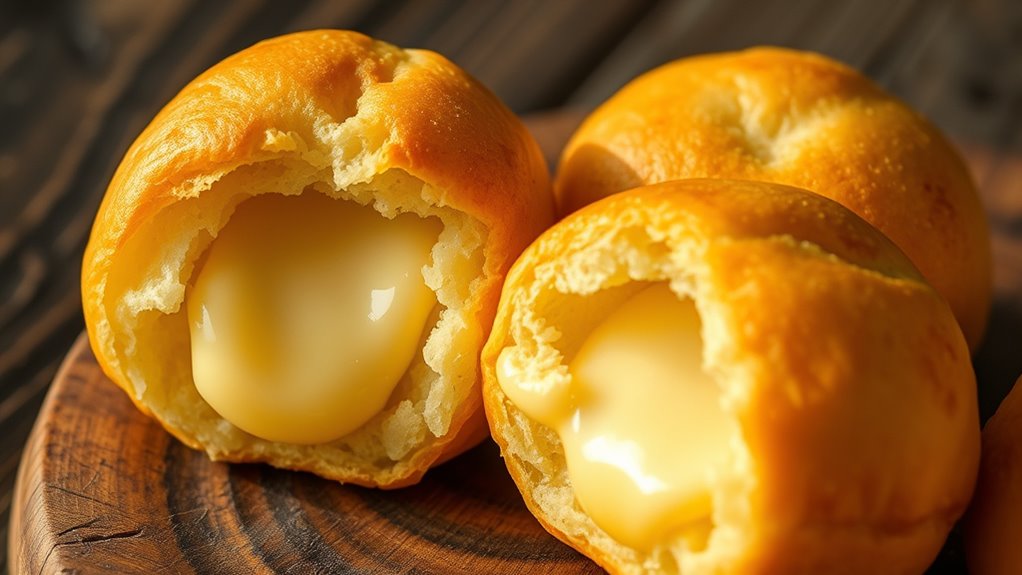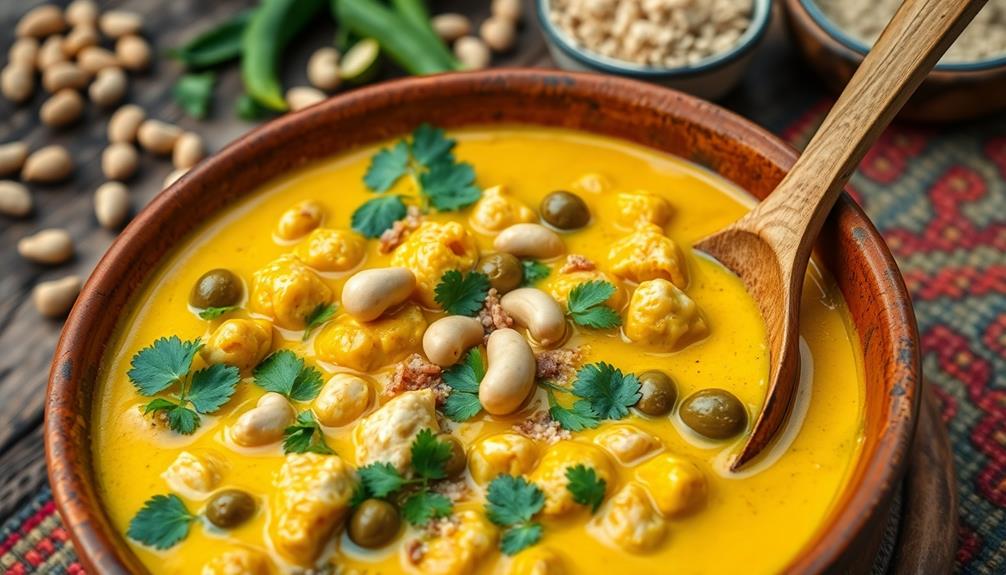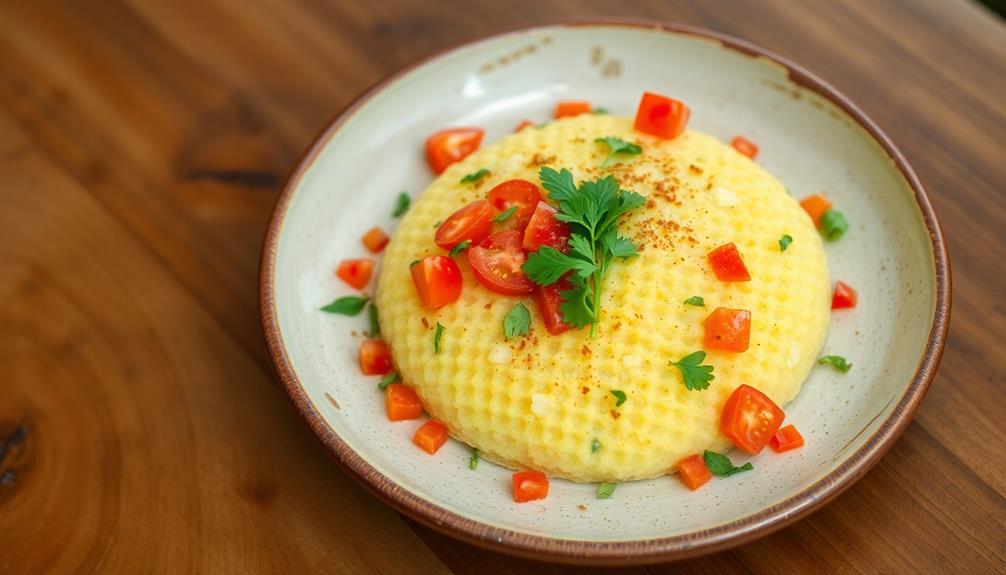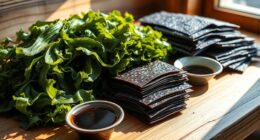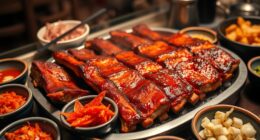To master authentic Pão de Queijo, understand how tapioca starch gelatinizes during baking. When heated, the starch granules swell, burst, and trap water, forming a chewy, elastic gel that gives the bread its signature texture. Controlling temperature and baking time guarantees proper gelatinization, leading to a light, firm, and flavorful result. If you keep exploring, you’ll discover how fine-tuning these factors elevates your baking to true Brazilian standards.
Key Takeaways
- Proper gelatinization occurs when tapioca starch absorbs hot liquid, swelling and bursting to create the bread’s chewy texture.
- Temperature control during baking ensures optimal starch gelatinization, affecting Pão de Queijo’s lightness and elasticity.
- Fully gelatinized starch helps trap moisture and supports cheese flavor integration, resulting in a cohesive, flavorful bread.
- Over- or under-gelatinization can lead to undesirable textures, so monitoring heat and timing is crucial for consistency.
- Mastering tapioca starch gelatinization allows gluten-free Pão de Queijo to mimic traditional Brazilian texture and flavor.
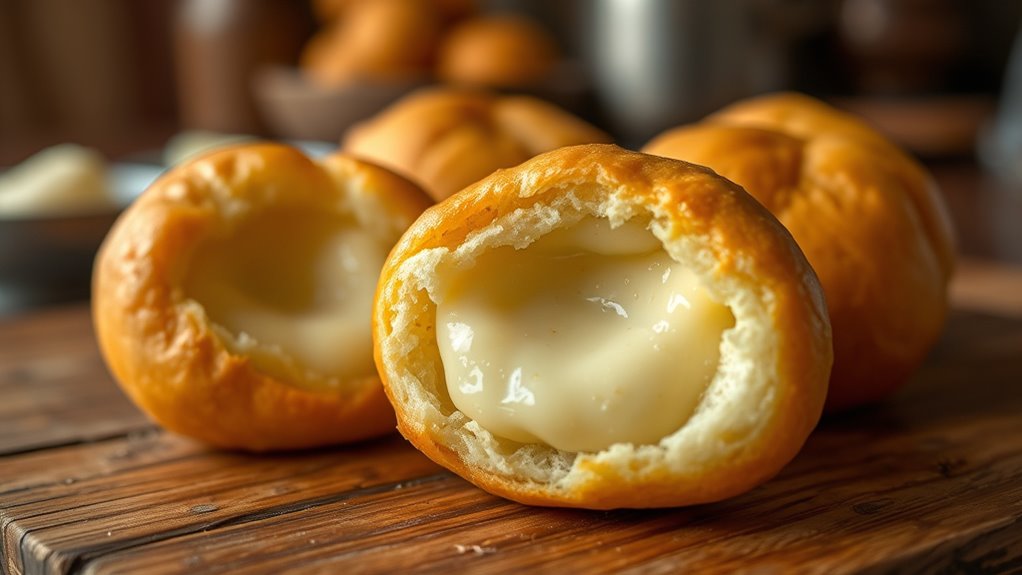
Brazilian Pão de Queijo is a delicious and irresistible cheese bread that has become a beloved staple across Brazil and beyond. If you’re exploring gluten free baking, this cheesy treat offers a perfect example of how tapioca starch can create a light, chewy texture without any wheat. The magic lies in the gelatinization process of tapioca starch, which transforms when heated to give Pão de Queijo its characteristic elasticity and chewy bite. Understanding this process helps you master the art of making authentic, melt-in-your-mouth cheese bread at home.
When you bake Pão de Queijo, the key is to get the tapioca starch to gelatinize just right. As the hot liquid hits the starch, the granules swell and burst, trapping water and forming a gel-like network. This network is what gives the bread its unique chewy texture and helps it hold together without gluten. Knowing how tapioca starch gelatinizes during baking allows you to tweak your recipe for perfect results every time. For example, the temperature of the liquid and the baking time influence the extent of gelatinization, affecting the final chewiness and rise. By controlling these factors, you guarantee your Pão de Queijo remains light yet firm, with that satisfying bite everyone loves.
The gelatinization process also plays a vital role in cheese flavor enhancement. When you incorporate cheese into your dough, the heat causes the fats and proteins to melt and mingle with the gelatinized starch, intensifying the cheese flavor. The heat also helps the cheese distribute evenly throughout the dough, resulting in a consistent cheesy taste in every bite. To maximize this effect, use high-quality cheese like Parmesan or a traditional Brazilian queijo Minas, which melt well and lend a rich, savory flavor. The heat-induced gelatinization ensures that the cheese doesn’t just sit on the surface but becomes an integral part of the bread’s texture and flavor profile. Additionally, understanding the gelatinization process can help you troubleshoot and refine your baking technique for even better results. Recognizing the importance of starch transformation allows bakers to optimize texture and flavor more effectively. Gaining knowledge of thermal behavior of starch can further improve your control over the baking process and final product.
Understanding how tapioca starch gelatinizes during baking empowers you to perfect your Pão de Queijo. It’s not just about mixing ingredients but about knowing how heat transforms the starch and cheese into something extraordinary. Whether you’re new to gluten free baking or a seasoned baker, this knowledge helps you create cheese bread that’s light, chewy, and bursting with flavor. With every batch, you get closer to replicating that authentic Brazilian taste, making each bite a delightful experience that celebrates the magic of gelatinization and cheese flavor enhancement.
Frequently Asked Questions
Can I Substitute Tapioca Starch With Other Flours?
You can try using alternative flours in your recipe, but keep in mind that tapioca starch provides unique gelatinization properties essential for the texture of pão de queijo. Gluten-free options like cassava or sweet potato starch work best, as they mimic tapioca’s stretchiness and lightness. Regular flours won’t give the same results, so if you’re seeking a true gluten-free version, stick with gluten-free options or experiment carefully with small batches.
What Is the Ideal Temperature for Tapioca Gelatinization?
You should aim for a tapioca temperature of around 140°C to 160°C during the gelatinization process. This range guarantees the tapioca starch granules fully absorb water and swell, creating the desired chewy texture. If the temperature is too low, gelatinization won’t complete, resulting in a less cohesive dough. Too high, and you risk breaking down the starch structure. Monitoring the temperature helps you perfect the gelatinization process for ideal results.
How Does Humidity Affect the Texture of Pão De Queijo?
Imagine humidity as an invisible artist shaping your pão de queijo’s texture. High humidity impact means moisture seeps into the dough, making it softer and potentially too chewy. Low humidity dries it out, risking a tough crust. You regulate moisture carefully—keeping environment steady ensures perfect, fluffy cheese bread. Proper moisture control prevents unwanted texture changes, helping you craft pão de queijo with just the right balance of crispiness and tenderness.
Can Frozen Tapioca Dough Be Baked Directly?
You can bake frozen tapioca dough directly, but handle it carefully. Let it thaw slightly for easier shaping, or bake straight from frozen for convenience. Make sure your oven is preheated to the right temperature, typically around 375°F (190°C), to get a perfect crust. Adjust baking time slightly longer if baking from frozen. Remember, proper frozen dough handling and correct baking temperature tips help achieve that golden, chewy pão de queijo.
What Are Common Mistakes That Prevent Proper Gelatinization?
Ever wonder why your tapioca dough doesn’t turn out just right? The secret lies in avoiding mistakes like overmixing the dough, which can prevent proper gelatinization, or using cold ingredients that slow the process down. When you overmix, you activate too much gluten, ruining the texture. Keep ingredients at room temperature and mix just enough to incorporate, and you’ll reveal the perfect, fluffy texture you crave.
Conclusion
Now that you understand the tapioca starch gelatinization secrets, you’re like an artist wielding a brush, ready to create perfect pão de queijo. When you master these techniques, each bite becomes a warm, golden sun rising on a flavorful horizon. Remember, this process transforms simple ingredients into a delicious symphony of texture and taste. With your newfound knowledge, you’re equipped to craft cheese puffs that shine like a beacon of Brazilian tradition.
